In: social activism
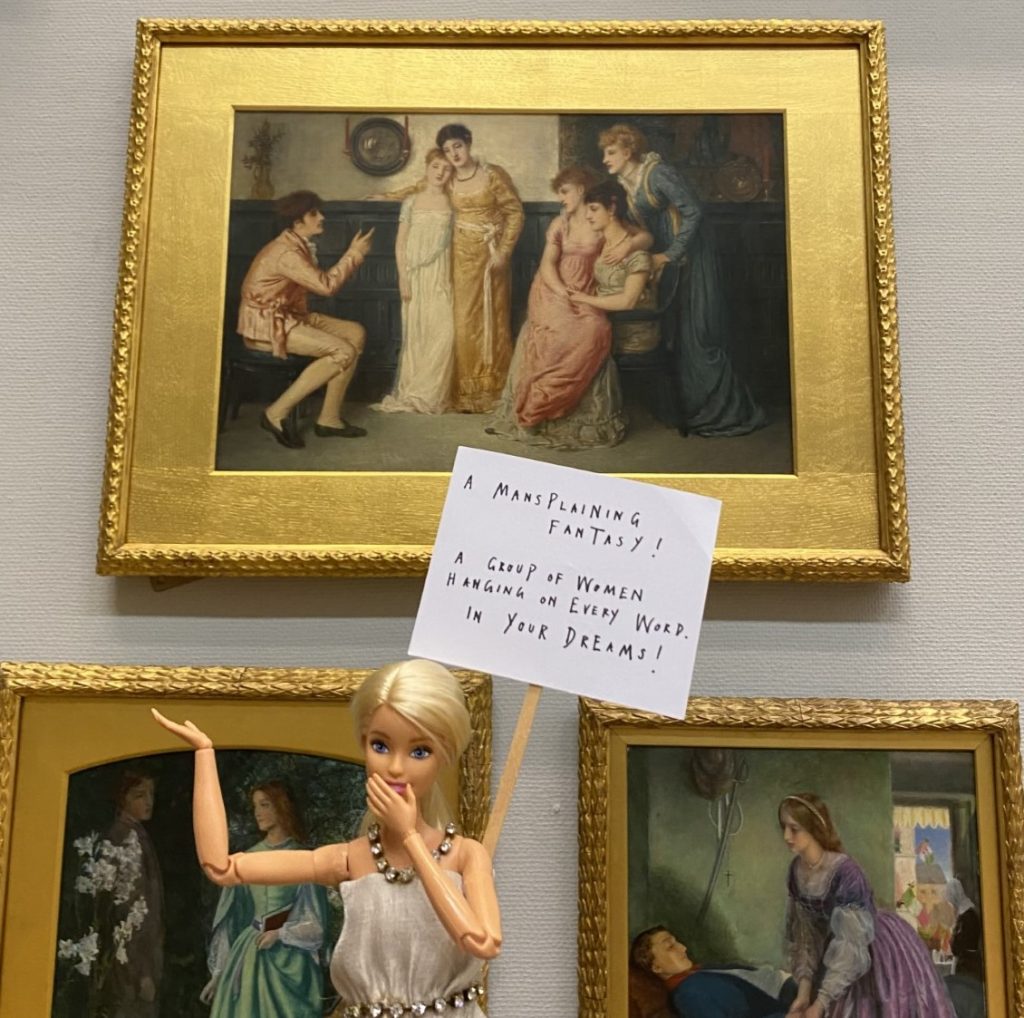
ArtActivistBarbie | Dr Sarah Williamson
August 11, 2023ArtActivistBarbie | Dr Sarah Williamson
Many years ago, when I was still working in art galleries, I was intimately involved with the first full ‘inventory’ of the Kenderdine Gallery’s art collection (now the College Gallery, at the University of Saskatchewan). This task involved documentation both visual and written, from shooting slides (yes, I am that old) and creating or augmenting artist and artwork files.
At one point, a coworker and I realized that there were more works by unknown artists than there were from female artists, let alone ‘contemporary’ ones : but I also remember an acquisitions meeting where yet another passel of karaoke modernist paintings by a second rate male artist were being considered for purchase (despite, as I pointed out, one of the people on the committee was the son in law of said artist, and we already had many works by this artist, and many more lesser imitations in this derivative genre. Unsurprisingly, I was asked to leave the meeting…).
I can’t help but feel nobody would be able to make ArtActivistBarbie leave, in a similar situation (yes, I am smiling as I type that). A performative persona of Dr Sarah Williamson, it feels appropriate to speak of ArtActivistBarbie as a person, unto herself, in this essay.
If you’re still swimming in that cesspool known as Twitter – sorry, ahem, ‘X’ – then perhaps you are already familiar with ArtActivistBarbie (@BarbieReports) who “has a finely tuned eye when it comes to calling out gender inequality in the arts, and she is not afraid of making a scene. Her provocative wit and fabulous wardrobe lend themselves to staged interventions, predominantly in art galleries and museums. Posing with her tiny, pithy placards, ArtActivistBarbie is photographed gently mocking or drawing attention to problematic exhibits and the images are shared with millions of Twitter users. She also challenges the biases inherent in so many curatorial labels and statements.
ArtActivistBarbie seeks to change the practices of these institutions, the bulk of whose collections have historically been commissioned and produced by men, representing many centuries of male power and privilege. Over 94% of artworks in publicly funded galleries [in the UK] are by white men and many objectify and demean women and girls. Making visible the lives and experiences of women and minority ethnic groups is vital for a more just and equal society.” (from here)
The origin of ArtActivistBarbie is thus : “The woman behind the project is Sarah Williamson, a senior lecturer in education and professional development at the University of Huddersfield. A few years ago, she was trying to find a way to engage her students with social-justice issues and feminist ideas, especially the problematic way women are portrayed in art. She wondered if Barbie, that plastic idealised woman, could become a vehicle for playful commentary on the “patriarchal palaces of painting”. Soon Williamson was gathering a doll army, clothing it in pieces handmade by her feminist mother in the 1970s, with new additions created by her sister. She handed each of her students a Barbie doll and a blank placard on a lollipop stick, then set them loose in Huddersfield Art Gallery.
The resulting mini-protest signs stopped visitors in their tracks, and the photographs of Barbie’s protests drew plenty of notice back in Williamson’s office: “I realised I had something which attracted everyone’s attention and catalysed conversations about how women are portrayed and represented not only in art, but society in general.”” (from The Guardian)
It’s also necessary to consider how “museums are somewhat newly self-reflexive about their role in shaping the culture and the discourse, and are working hard to stay relevant and expand the canon—and to grow their audiences.” (That’s from a recent article in ArtNews that appropriately decries the slipshod ‘critique’ offered by the Brooklyn Museum’s exhibition Pablo – matic – and although ArtActivistBarbie seems to ‘shoot from the hip’, her aim is more accurate, and considered, in the larger discourse of whom and what cultural institutions serve – and don’t….)
Much more about ArtActivistBarbie’s caustic yet comedic commentary (comedy, it has been said, is just rage in fancy dress, and Barbie has no shortage of snazzy outfits) can be enjoyed here. There are a number of interviews with Dr Williamson that are as educational as they are engaging.
~ Bart Gazzola
Read More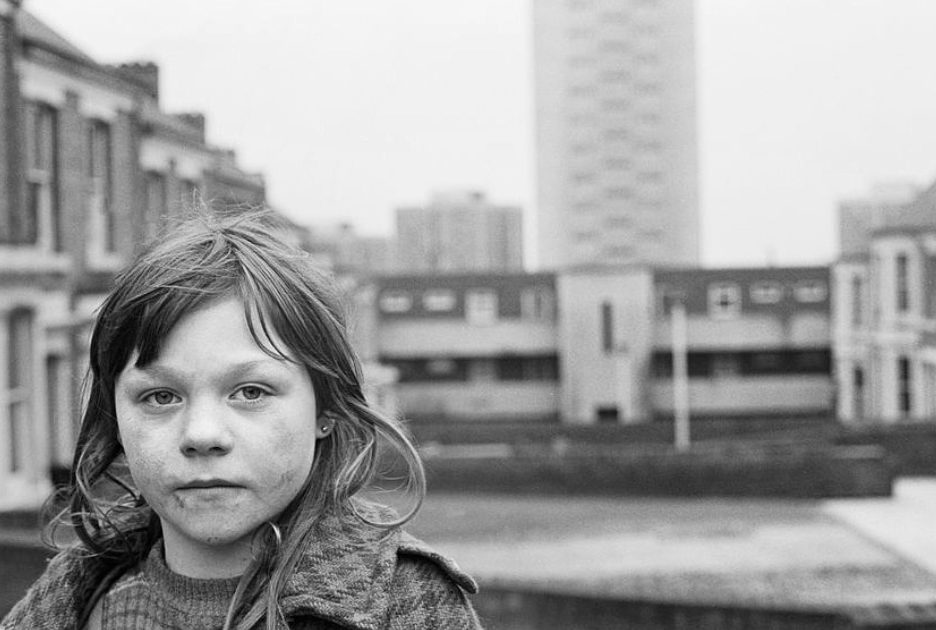
Tish Murtha | Elswick Kids | 1978
August 4, 2023Tish Murtha | Elswick Kids | 1978
All we wanted was everything. All we ever got was coal.
(Bauhaus, from the album The Sky’s Gone Out, 1982)
Patricia Anne “Tish” Murtha (1956 – 2013) was a British photographer best known for her images of working class life in Newcastle upon Tyne and the North East of England. Murtha’s work is a raw documentation of these communities – and often youth within these social groups – at a time when British Prime Minister Margaret Thatcher waged war on her own citizens, embracing a neo – liberal cruelty that is like a virus whose symptoms can be still seen in contemporary post Brexit Britain.
The images captured by Murtha evoke notions of a ‘third world’ country, with the scenes of desolate and despairing youth amidst a wasteland that – being shot in black and white – emit a hopelessness that reaches across the decades. Or perhaps it is simply combining with the contemporary desperation among working class communities in these places now.
From here : “In 1976, aged 20, Tish left home to study at the famous School of Documentary Photography at The University of Wales, Newport under the guidance of Magnum member David Hurn.
She took many photos in Newport, including The former Prime Minister James Callaghan opening up a new stretch of the M4, as well as documenting Aubrey Hames’ year as Mayor of Newport in the Queens Silver Jubilee year (1977-1978). Tish also worked with the South Wales Argus during this time and photographed the local election campaigns.
When she returned to Newcastle, she began to document the lives of her friends and family and numerous other projects.
Tish’s work was often concerned with the documentation of marginalized communities from the inside. She invested her time building relationships of trust, which allowed her access to different parts of the communities that she photographed. Her approach was informal, generating an understanding of what she was doing by giving copies of her photos to the people in them. The young people she photographed as part of the Youth Unemployment and Juvenile Jazz Band exhibitions showed how tenacious, resourceful, clever and resilient they were (and had to be) – Tish was always fiercely protective of them.
She felt she had an obligation to the people and problems within her local environment, and that documentary photography could highlight and challenge the social disadvantages that she herself had suffered.”
Three books of her photographs have been published posthumously : these are Youth Unemployment (2017), Elswick Kids (2018) and Juvenile Jazz Bands (2020).
More of Tish Murtha’s work and her life (as her daughter is maintaining her archive and ensuring her mother’s work is given its appropriate place in terms of history and art) can be seen here.
~ Bart Gazzola
Read More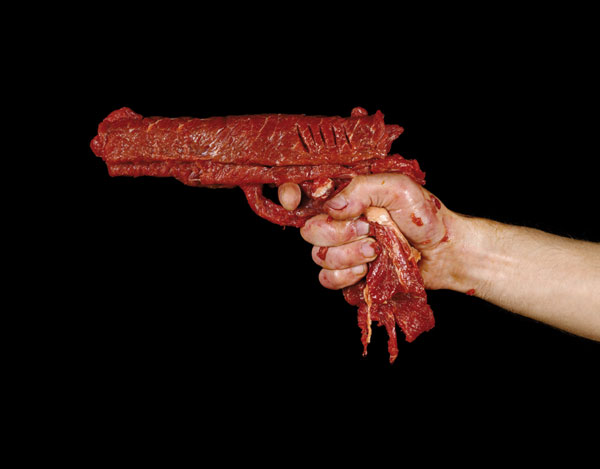
Dimitri Tsykalov | MEAT | 2007 – 2008
July 28, 2023Dimitri Tsykalov | MEAT | 2007 – 2008
It’s not a new idea that firearms make acts of violence ‘too easy’, almost ‘antiseptic’, as they minimize the necessary physical contact intrinsic to other acts of brutality. This is an idea that’s been raised about technology since we began using it to kill each other.
(At the risk of seeming flippant, I must also inject a quote that came to mind when I first encountered images of Tsykalov’s MEAT : Invariably, the first question asked about a new technology is, “Can this make killing less of a hassle?” The second being, “Can I have sex with it?”…)
The implicit ‘removal’ or ‘remoteness’ (I’m reminded of the ski pole scene from Timothy Findley’s The Wars, for example, where the firearm and act of murder almost seem separate from the character himself) makes it almost a ‘trivial’ or ‘throwaway’ action to fire a gun.
Dimitri Tsykalov’s MEAT works offer a counter to that, in a grotesque manner that is excessive : I’ve debated writing about Tsykalov’s ‘armaments’ for a while, unsure if they’re too flippant, or too horrifying, or a combination of both that is as unpalatable as gripping cold flesh while your hands are stained and overrun with effluvia…
These works don’t pretend to an aesthetic distance (like in Serrano’s work, or some other artists I’ve talked about here who – like myself, when I worked with fat, bone and meat for over two decades – are interested in creating inappropriately beautiful artwork) : I feel that Tsykalov takes pleasure in our revulsion and wants to evoke it from us, and considering what he’s ‘butchering’ the meat, flesh and bone into, this is not inappropriate. There’s a swagger here, a bravado that intends to make us ill. Meat and guns are, after all, metaphors for penises or toxic masculinity, and Tsykalov alludes to that (even with the titles that reference specific guns).
Tsykalov, in creating work that intersects with brutality and our capacity for it, as a species, has taken an opposing artistic path to someone like Ralph Ziman with The Ghosts Project (a past Curator’s Pick you can see here).
Tsykalov’s own words : “In these pictures I recognize the murderers within me, I recognize love and death within me; in these pictures I recognize my flesh as the cannon fodder it is and will be for the rest of my life. In contrast the secondary meat in these shots – the one that rots and that kills, the animal meat that is used to create the fleshy weapons – seems unscathed, sanguine and elegiac. It is incredibly alive, it is cannon flesh and we are already mortal.”
Dimitri Tsykalov was born in Moscow (1963) where he attended Polygraphic Institute of Moscow (1982-1988). He currently lives and works in Paris.
More of his work can be seen here.
~ Bart Gazzola
Read More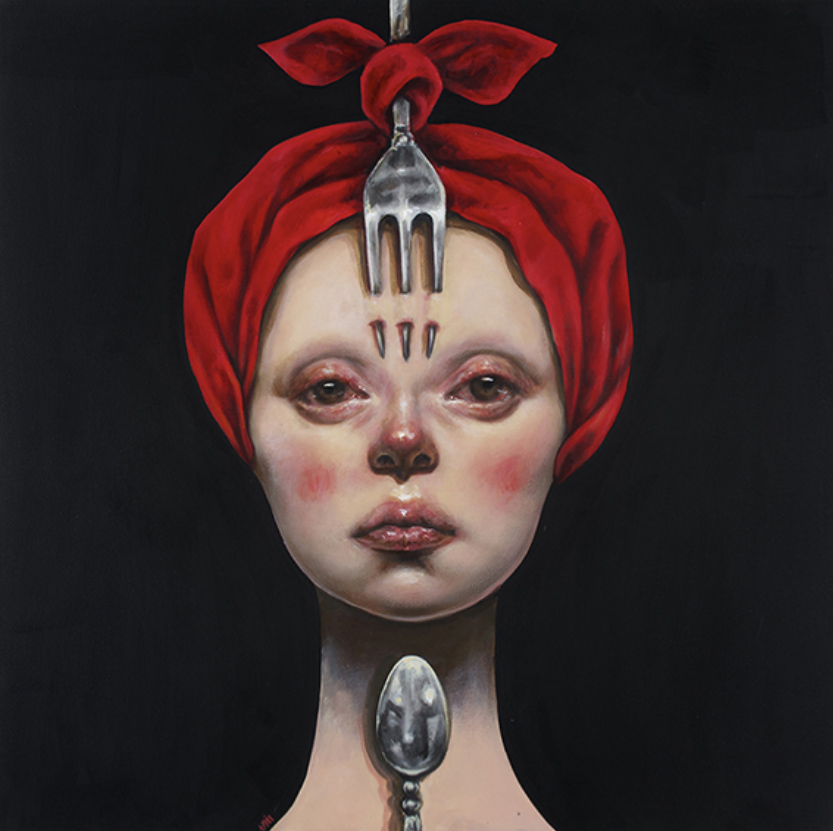
Afarin Sajedi | Chef Offer | 2013 – 2014
July 6, 2023Afarin Sajedi | Chef Offer | 2013 – 2014
“You will eat less than you desire and more than you deserve.”
(from The Menu, 2022)
The works in Sajedi’s Chef Offer series have evocative if direct names (I prefer to say ‘names’ over artwork titles in deference to her figures, with their poise and power).
These includeThe Soldier (2013), Like A Queen (2013) and Like A King (2013). The header image – breaking this pattern – is simply Fork (2013). The latter seems less stoic and more a warning to the viewer meeting her gaze….
Even the superficially absurd head pieces that her women wear are less amusing than unsettling in their elaborate nature: the pale faces, flushes on the cheeks and uncanny presence of the women in Chef Offer inspire anxiety more than amusement…
I recently rewatched The Menu, a horror film about the pretentious restaurant ‘scene’ that is rife with dark humour. Many of the harsh if unflinching ideas in The Menu are present in another horror film that dryly mocks the art world : Velvet Buzzsaw (2019). With both of these films I have rarely laughed so hard – and appropriately – at horror. Both of these films came to mind in considering Sajedi’s Chef Offer series.
The women that Sajedi ‘offers’ us seem to have an affinity to the Menu character Elsa, whose inscrutable, amused hint of a smile portends nothing but appropriate suffering for the ‘diners.’ It’s Elsa’s words I opened this essay with : and the exchanges of dialogue in The Menu offers a place to stand and consider Afarin Sajedi’s women in Chef Offer.
An example (and try to read this without picturing one of Sajedi’s women speaking as Chef Slowik, here):
Chef Slowik: So, the question is, do you wanna die with those who give, or with those who take?
Margot: But I die either way? It’s arbitrary.
Chef Slowik: No, it’s not arbitrary. Nothing in this kitchen is arbitrary. Please pick. These decisions are important, and, uh, our menu is strictly timed. In 15 minutes, I’ll take a break between courses, and that is how long you have to decide. It’s our side or theirs. In the meantime, please return to your seat. The next dish is exquisite.
Afarin Sajedi was born in 1979 in Shiraz and relocated to Tehran in Iran to study at Tehran Azad University where she earned a degree in graphic design. Afarin’s paintings are marked by a melding of technique and creativity, and often powerful in their presentation. Her subjects include theatrical characters, sometimes with overtly colourful, almost clownish faces, that are inspired by Japanese theater in tandem with symbols of western religious art that contrast and collide with the contemporary world. Afarin’s “characters are usually royal, proud, and silent with a deep look.” (from her site)
More of her work can be seen here and her IG is here.
~ Bart Gazzola
Read More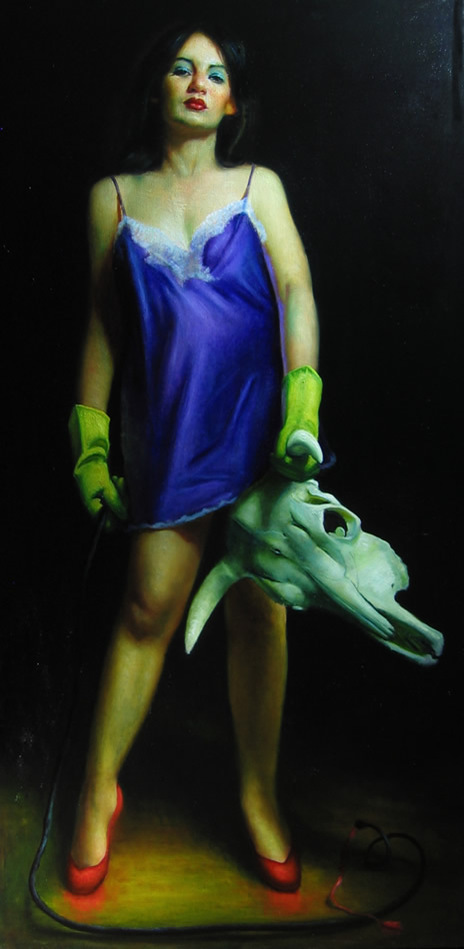
Rose Freymuth-Frazier | Woman Fighting Bull | 2007
June 30, 2023Rose Freymuth-Frazier | Woman Fighting Bull | 2007
I am tempted to simply comment that this is my offering – my criticism, in a visual manner – of the online debate around the exhibition at the Brooklyn Museum that purports to explore the misogyny of Picasso and what might be the inflation of his genius in the Western art canon. If you’re unfamiliar with what I’m referring to by this comment, this link may help.
There is a carnivalesque aspect – and attitude, with her figures – in much of Freymuth-Frazier’s artwork. Recurring motifs make her paintings like a story, and the gazes and stances have a cinematic quality. Humour – often dark, or with an amusing caustic edge – is also present in her rendered scenes.
I enjoy the elements in this that conflict and conflate with the title : the yellow cleaning gloves (when I see these, I can almost smell the rubber of them), the rich red heels that seem almost to bleed colour onto the floor beneath them, the fine negligee matching the eye shadow, and all offset by the ‘trophy’ of the bull’s skull gripped in a cavalier and triumphant manner. If some of Artemisia Gentileschi‘s tableau of the (appropriate, perhaps) beheading of outrageous men comes to mind, that is only fitting.
Freymuth-Frazier’s woman looks as though she just dealt with a situation that though not her fault became her responsibility and will brook no complaints – or any of your ‘bull’, if I may engage in a pun. It’s a look familiar to us from some of the women in Romina Ressia‘s metaphorical portraits. Less flippantly, Freymouth-Frazier’s figures are the children of Paula Rego‘s characters, too : sometimes presenting uncomfortable but unapologetic experiences, direct and engaging in formal and conceptual ways. There’s a description of Rego’s work that applies very well to Freymouth-Frazier’s too : “Her paintings are a cryptic glimpse into an intimate world of personal tragedy, perverse fantasies and awkward truths.”
Rose Freymuth-Frazier has studied at the Art Students League of New York and the New York Academy of Art.
From her site :
“Rose’s mother and grandmother were both artists. Her work draws from a deep connection to the women who came before her as well as German art and culture passed down through her German Jewish refugee family, particularly that which was labeled as “degenerate” art. Her large-scale figurative oil paintings draw on a range of sources from intimate moments with loved ones and her Persian cat, to the detachment of pinup and soft porn, stock photography, and advertisements. Through an exploration of the subconscious, she depicts themes both personal and universal.
Her work has been exhibited internationally, and is included in private collections around the world, including The Bennett Collection of Women Realist, Collection of Gillian Flynn, Collection of Milane Duncan Frantz and the Collection of Michele Peterson.”
Her site and much more of her fine work can be enjoyed here and her IG is here.
~ Bart Gazzola
Read More
Judith Schaechter | Eastern State Penitentiary | 2010-2011
June 16, 2023Judith Schaechter | Eastern State Penitentiary | 2010-2011
Schaechter works in a medium – stained glass – that is often consigned to the past, a method that most would be surprised to find is still employed by various artists. In terms of this, her thematic choices for this series of works installed in the Eastern State Penitentiary in Pennsylvania being a re interpretation of an allegory (most notably executed in 1559 by Pieter Breugel the Elder) that dates back over a thousand years is a melding of material and intent that literally shines.
It’s installation in a penitentiary offers even further intersections about indulgence and discipline, redemption and rashness, but also harkens to how this was a form of art that was essentially populist, offering narratives and stories to any who encounter it, even in unexpected places that foster moments of unanticipated joy.
Judith Schaechter is a very accomplished artist. She has lived and worked in Philadelphia since graduating in 1983 with a BFA from the Rhode Island School of Design Glass Program. She has exhibited widely across the United States, and has been the recipient of a Guggenheim Fellowship, two National Endowment for the Arts Fellowships in Crafts, The Louis Comfort Tiffany Award, The Joan Mitchell Award, two Pennsylvania Council on the Arts awards, The Pew Fellowship in the Arts, and a Leeway Foundation grant, and she is a 2008 USA Artists Rockefeller Fellow. Much more about her impressive career can be seen here.
An excerpt from her statement about her work:
“I found the beauty of glass to be the perfect counterpoint to ugly and difficult subjects. A radiant, transparent, glowing figure is not the same as a picture of a figure (which reflects light). It’s a blatant reference to holiness or some type of “supernatural” state of being. In terms of my figures, although they are intended to be ordinary people doing ordinary things, I see them as having much in common with the old medieval windows of saints and martyrs.
They seem to be caught in a transitional moment when despair becomes hope or darkness becomes inspiration. They seem poised between the threshold of everyday reality and epiphany, caught between tragedy and comedy.
It seems my work is centered on the idea of transforming the wretched into the beautiful in theme as well as design. For me, this means taking what is typically negative — say, unspeakable grief, unbearable sentimentality, or nerve-wracking ambivalence, and representing it in such a way that it is inviting and safe to contemplate and captivating to observe (to avoid ending with preposition). I am at one with those who believe art is a way of feeling one’s feelings in a deeper, more poignant way.
Medieval windows sought to confer inspiration and enlightenment to those who would see it. Beholding a stained glass window can enable, encourage, and literally enact the process of being filled with light. It sounds like some kind of preternatural phenomenon, but it’s a physical fact. While one is busy identifying and empathizing with the image, one also physically experiences the warming, filling sensations of light. It’s so persuasive not because the pictures are convincing narratives but because the colors are overwhelming and the light is sublime…”
Besides the imposing – perhaps edifying, considering its location – Lent work, Schaechter has also interspersed smaller slim artworks in various sites in the Penitentiary, with titles that evoke emotion and consideration like The Weeping Chorus, Confines, Mother or Sister.
Prisons are spaces that we ignore in most conversations about society, let alone cultural communities: except for when the ‘debate’ rears its ugly head in the public sphere about whether they are spaces designed for rehabilitation or purely for a punitive joy that usually seems to have a vague stench of hypocrisy about it. In imagining what it would be like to stand in the presence of these works, the idea of ‘redemption’ – a word I am uncomfortable with, as like too many words it is used with a biased or easy intent – comes to mind.
More of Judith Schaechter’s unique artwork can be seen here.
~ Bart Gazzola
Read More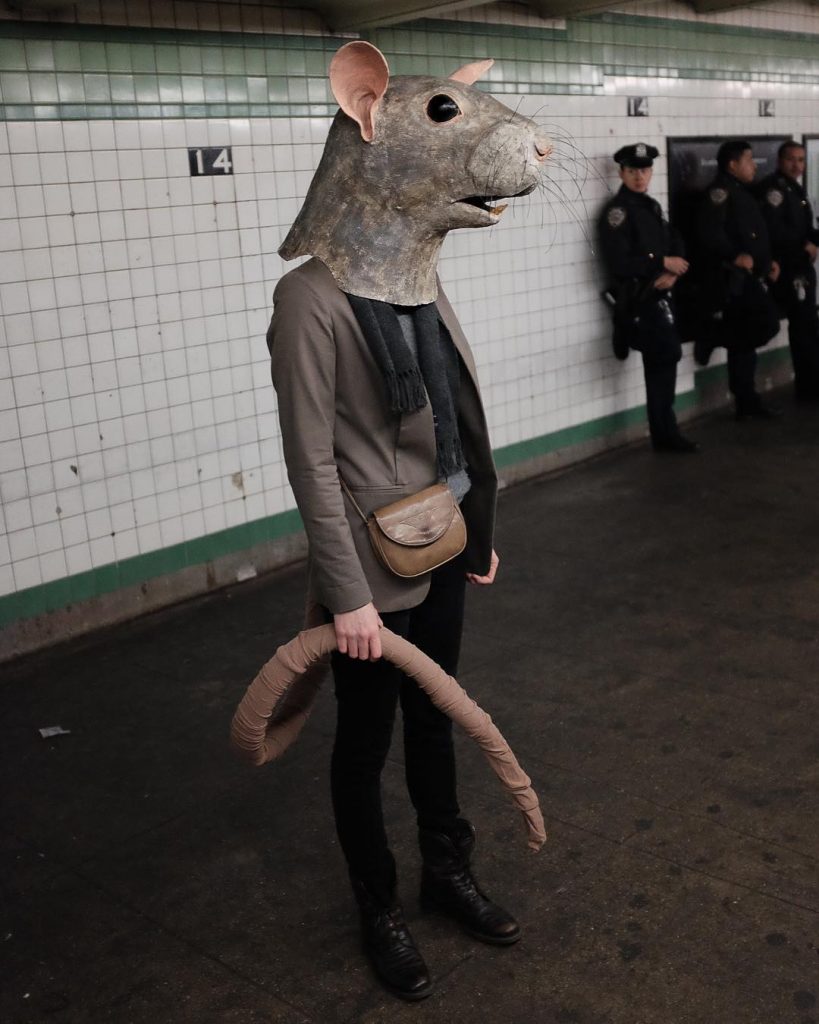
Liz Sexton
June 9, 2023Liz Sexton
“You aren’t a tiger. You’re a rat. No, that’s an insult to a noble and numerous species of rodent. You’re less than a rat.”
(Neil Gaiman, Anansi Boys)
When considering Liz Sexton’s Rat mask (which the artist created for Halloween and was documented in Brooklyn, New York, several years ago, amidst the visceral urban subway) and the stylish, self possessed Ratman I am initially reminded of the Rats (note the capitalization) and the Rat Speakers from the book Neverwhere.
Humour and horror (both heavily flavoured with the absurd in a delightfully performative manner) inform Sexton’s works. That’s one of the reasons why I included the images with her cat among those I’m sharing, as the cat’s unimpressed languor challenge the stoic existential nature of her ‘players’ (sometimes Sexton is the one donning the masks, other times not) that become something so much more in her masks, especially as they trod the public sphere. The Ravens (yes, I feel the need to formalize the characters in these scenes) on the subway may be harbingers of doom (if we’ve learned nothing from Edgar Allen Poe, don’t ask a Raven a question you don’t want answered, ahem) or simply out for the evening, on the way to meet fellow feathered friends : please don’t bother them, as a group of ravens IS called an ‘Unkindness.’
Other characters are engaged in equally banal every day activities, while others gaze directly back at us in a challenging manner, and others are captured in quiet moments of introspection, where we seem to be intruding on private moments.
Whether these are ‘disguises’ or new personas, I leave to your own discretion in any conclusion you make.
The words of the artist : “Most everything I create is meant to be interacted with, whether masks, puppets, or simply objects—they’re all intended to be worn, held, or touched….With the wearer concealed under a larger-than-life mask, it becomes as much a human with an animal head as an animal with a human body—a very interesting thing to interact with.
I often work on threatened species, particularly sea creatures, and photograph the animal masks worn in very human habits, highlighting the displacement that many creatures are currently experiencing. I also work on more common animals that we might share our surroundings with but don’t necessarily notice or engage with. Presented on a human scale, they share our world, becoming visible members of our communities.“ (from here)
In this light, I am also reminded of the moment – in Welland’s rust belt wonderland – when I met up with a fox late at night. Their unflinching gaze let me know who was the interloper, and it wasn’t them….
Liz Sexton has lived and worked in Paris, Berlin, and New York, and has recently returned to her Midwest roots, calling Saint Paul, Minnesota home. For now. Experienced in a wide range of mediums, these days she favors paper mâché for its versatility and accessibility. She enjoys creating sculptural objects, often inspired by the natural world.
Liz Sexton’s solo exhibition Out of Water is on view at the Minnesota Marine Art Museum May 6 – September 3, 2023.
Much more of her work can be enjoyed at her site here and her IG can be seen here.
~ Bart Gazzola
Read More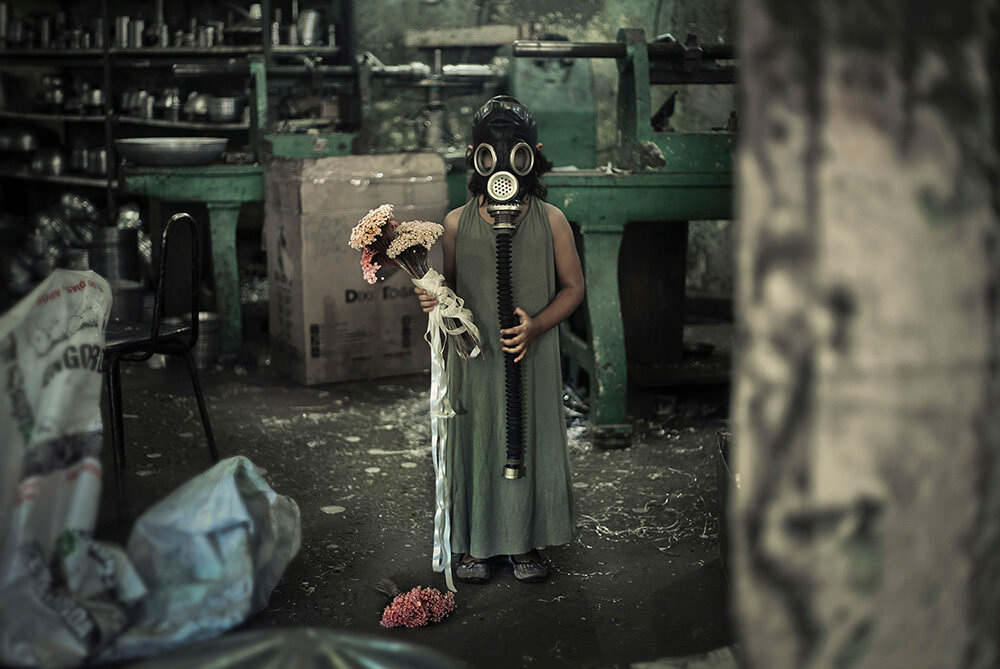
Hifa Cybe | Girl with the Gas Mask | 2020
June 3, 2023Hifa Cybe | Girl with the Gas Mask | 2020
I have heard the languages of apocalypse, and now I shall embrace the silence.
(Neil Gaiman)
Did you see the frightened ones?
Did you hear the falling bombs?
Did you ever wonder why we had to run for shelter when the promise of a brave new world unfurled beneath the clear blue sky?
(Goodbye Blue Sky, Pink Floyd)
I am convinced – though I’ve had difficulty tracking it down – that I read a line in Pasternak’s Doctor Zhivago, where one of the characters is talking of how, during the Russian civil war between the Whites and the Bolsheviks, it was a time when children only survived by eating the flesh of the dead (my memory of this line, even if invented, is quite visceral, and that intersects with some of Hifa Cybe’s work about memory – the veracity of it in personal narratives – too).
The quote I begin this piece with is – as some of you will know – from Pink Floyd’s The Wall, and this song always struck a chord regarding how in post WW II Britain a hoped for peace gave way to the Cold War, and that the idea – the fear – of an impending nuclear apocalypse – that we might bring about our own ending in a previously unimaginable manner – suffused a generation of children, as dour and suffocating and infecting as the bombs that ravaged people during WWII, and that do so still, now, perhaps forever….
I have little to actually say about Cybe’s artwork here : it’s power, simplicity in contradictions and the anxiety it induces are so intensely visual, so well executed, that my words would simply be a barrier to the viewer’s immediate engagement with it. An image like this also exposes the trite self aggrandizing act of Ai Weiei’s ‘reimagining’ of the image of drowned infant Alan Kurdi that in 2015 became the defining symbol of the plight of Syria’s refugees.
There is one thing to consider, though, in light of how Cybe’s research and artworks delve into trauma, especially in terms of memory and childhood. Here, in Niagara (as I make this post at the beginning of Pride month), we’re seeing the latest iteration of hatred against LBQT+ people, with a recent bilious spurt of it from a catholic school trustee : surely I’m not the only one who finds the rank stench of that hypocrisy, from a cult that has harmed so many – and so many children – too much? With this in mind, and looking at Cybe’s image, I am also reminded of friends I grew up with, in extremist religious environments, and that this scene might be a more exact psychological representation of their experiences, and tools of survival….
Luiza Jesus Prado, known as Hifa Cybe, is a transdisciplinary artist born in Guaratingueta, Brazil. She uses artistic tools such as photography, performance, video art, installation, sculpture, painting, new media, body art, music and drawing along with physics, psychology, neuroscience and philosophy. Cybe’s research is specifically on memory and the artist often explores topics of violence, sexual trauma, sociopolitical issues and minorities within Latin America.
This image is from a larger body of work under the aegis of Photo Homeostasis – Reprocessing Memories of Violence. The quote I began this essay with – from Neil Gaiman – is also the closing salvo from one of his stories in Endless Nights, which speaks of survival and even strength in the face of trauma.
Much more of Hifa Cybe’s artwork and research can be seen here.
~ Bart Gazzola
Read More
Rich-Joseph Facun | Little Cities | 2022
May 26, 2023Rich-Joseph Facun | Little Cities | 2022
…it takes an ocean of trust in the kingdom of rust…
(Doves)
The Cuyahoga River won’t kill you no more.
They cleaned it up back in ’74.
Well, you might get sick – but welcome to Ohio.
(Luke Doucet)
As I get older, there are some memories that still have an unexpected vivacity : and living again in the city and region where I grew up offers an odd looping of recollection, with elements of nostalgia – and the opposite of that, which might be cynicism or nihilism – informing and deforming my thoughts.
When I first encountered Rich – Joseph Facun’s images – specifically his Little Cities series – I felt transported back to my late teens and early twenties and shuttling back and forth between Windsor / Detroit and St. Catharines, seeing the underbelly of the rust belt wonderland. Specifically taking the train, and thus getting glimpses of smaller urban spaces across Southern Ontario that are often unseen or unconsidered, simply spaces to traverse on the way to somewhere else, not ‘valid’ to be ‘seen’ but as a space to be left behind or to be traversed with your mind – and destination elsewhere.
Facun’s scenes are part of a story that unfolds amidst the post-industrial United States – and these are spaces I’m familiar with from Niagara or the Windsor / Detroit region, that might be a ‘kingdom of rust’ or the ‘rust belt wonderland’ : a detritus of past ‘progress’, leavings of history that we might ignore or not acknowledge but that are literally part of the [memory of] landscape.
In Little Cities Rich-Joseph Facun “guides viewers on a meandering meditation through Southeastern Ohio by depicting the vernacular post-industrial landscape. In their quiet formality, the images call to mind past dreams, present disillusionment, and gently nudge us to look beyond what can be seen on the surface. Through recurring motifs, Facun excavates remaining signs of the Indigenous communities who once called this region home. In mankind’s hubris, we want to believe we shape the land we live on. Facun’s photographs remind us that the landscape contains memory, and it is witness to our misdeeds.” (from here)
Rich-Joseph Facun is a photographer of Indigenous Mexican and Filipino descent. His words : “His work aims to offer an authentic look into endangered, bygone, and fringe cultures—those transitions in time where places fade but people persist.
The exploration of place, community and cultural identity present themselves as a common denominator in both his life and photographic endeavors.
Before finding “home” in the Appalachian Foothills of southeast Ohio, Facun roamed the globe for 15 years working as a photojournalist. During that time he was sent on assignment to over a dozen countries, and for three of those years he was based in the United Arab Emirates.”
More of Facun’s work can be seen here and his IG is here. He has produced a publication for Little Cities, and I encourage you to spend some time with his Black Diamonds and 1804 series. Facun reminds me of Mary Ellen Mark‘s assertion as to how “photography is closest to writing, not painting. It’s closest to writing because you are using this machine to convey an idea. The image shouldn’t need a caption; it should already convey an idea.”
~ Bart Gazzola
Read More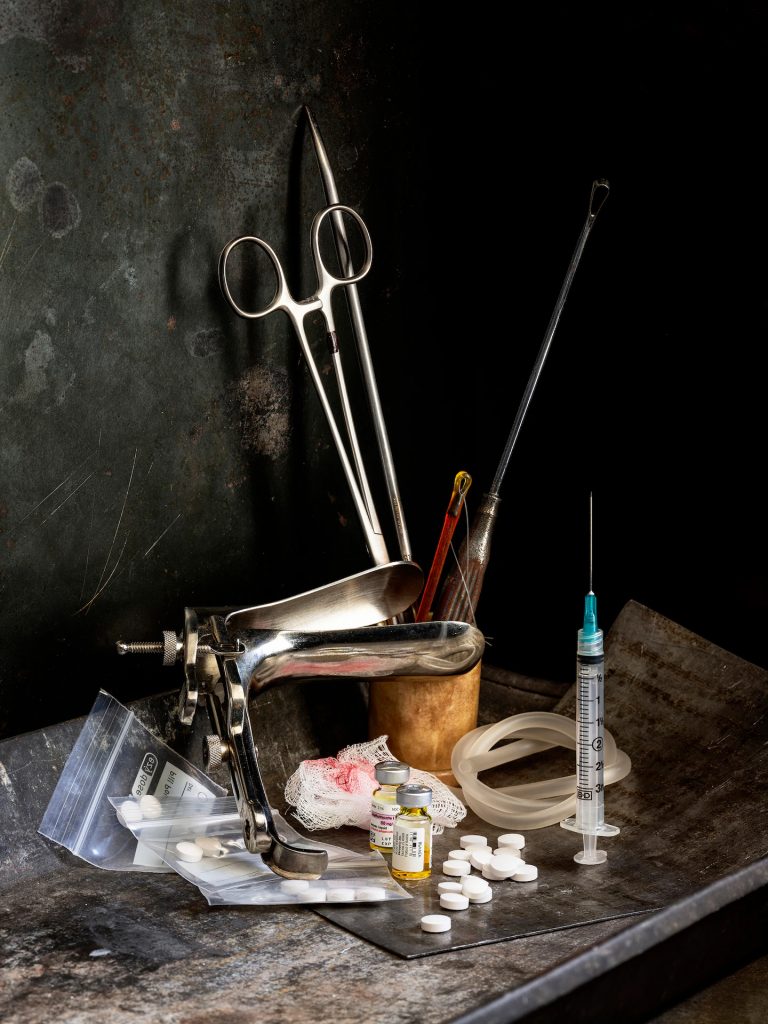
Beth Galton | Aftermath
May 19, 2023Beth Galton | Aftermath
[Galton’s] photographs, created with the help of prop-stylist Bette Blau, investigate the consequences to reproductive health and freedom after the Supreme Court’s decision in June to overturn Roe v. Wade. Since then, information about how to give oneself an abortion has surged across social-media platforms. This is the sad, secret knowledge passed by rumor and word of mouth in the absence of safe and legal abortion care.
* * * * * * * * * * * *
Among the Dutch still lifes, there is a subgenre known as vanitas paintings, which serve to remind the viewer of her mortality through not-so-subtle emblems such as clock faces, burning candles and human skulls. Galton, making visible the private horror of terminating a pregnancy without the protection of the law, performs the gesture even more literally. Her still lifes force us to contemplate the possibility of the mother’s unnecessary death.
(Dana Goodyear)
Dr. Savita Halappanavar’s needless death is where we will begin in considering Beth Galton’s images Aftermath : The Overturning of Roe V Wade.
Halappanavar (1981 – 2012) “was a dentist of Indian origin, living in Ireland, who died from sepsis after her request for an abortion was denied on legal grounds. In the wake of a nationwide outcry over her death, voters passed in a landslide the Thirty-Sixth Amendment of the Constitution, which repealed the Eighth Amendment of the Constitution of Ireland and empowered the Oireachtas to legislate for abortion.” One might say that her gratuitously cruel death – which can be laid at the feet of the catholic church which for too long has denigrated justice in too many countries – galvanized the people of Ireland to a more humane and informed position.
If I may engage in a rude observation, it is notable when such a formerly staunch catholic country as Ireland can shed the barbarism of that cult to acknowledge the essential autonomous humanity of people. But perhaps the legacy of the Magdalene Laundries are clear in their minds….
Galton’s images are quiet : a superficial glance will not immediately reveal their truth, but these are as meticulously well executed as many of her more commercial works. But they are not initially recognizable for what they are, with their aesthetic acumen (or – perhaps more likely – as a man, I don’t recognize certain tools. Though I’m surely part of any intended audience, it is more so something I’m being taught rather than having a necessary yet unwanted familiarity with them….and that ignorance on my part is just a small piece of a leviathan of such willful ignorance of church and state in Galton’s country, and my own…).
In an article about this series here, notes are offered such as with Bodily Harm : “Bodily harm caused by wire hangers, knitting needles, douches and hard objects. Emblems from the nightmare past, in the spotlight of now.” Another – Back Alley Abortion – presents “objects traditionally used by medical professionals [that] are also used illegally to perform abortions. Also represented is the abortion pill, shipped to states where abortion is now illegal.”
Galtan is a citizen of the U.S., and this debate is raging there and – as happens with Canada – it’s spilling into our spaces, tainting any genuine informed debate with religious ignorance and outright lies and hypocrisy (I live in Niagara, where former ‘Bishop’ Wingle all but had a stroke when Dr. Henry Morgentaler was awarded the Order of Canada for his work in providing necessary health care. Wingle’s voracious hypocrisy only ceased when it was revealed that one of his ‘priests’ was a serial child molester, at which point he resigned, ran away and hid and the facts are still unclear on how much Wingle abetted or ignored. Do I truly need to ask why acolytes of this cult are being platformed regarding this issue, health care and so many others where their contribution is vile and ignorant?)
Galton’s works are subtle but have much to say : an award winning photographer who lives and works in New York City, Galton’s “images and short films tell stories – the story of memories, of what and how we eat together, a love of nature, and the pleasure of shared experiences.”
It’s also worth noting that the aesthetic discipline of Galton’s images – the beauty in horror, perhaps – is tempered by the facts of what she’s sharing.
Too often – which we’re seeing in Canada, right now – there’s intentional misrepresentation and outright lies around the issue (again, copying what happens south of us, where SCOTUS members lied outright about their intentions, and quote Medieval Witchfinders while bleating they are ‘moral’). Galton’s works remind us – those of us who never knew, choose not to know or hypocritically ignore – of facts : specifically that within the erroneously snivelling assertion of being ‘pro life’, that no such concern is shown – the opposite, in fact – for women.
More of this series can be seen here and Beth Galton’s site is here.
~ Bart Gazzola
Read More
Recent Comments